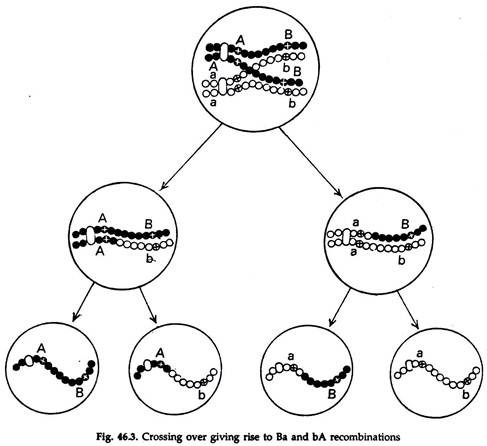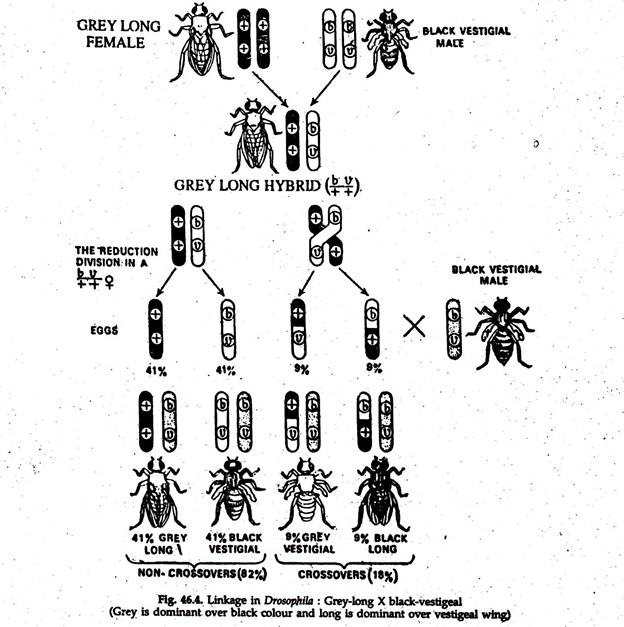In this article we will discuss about the linkage and crossing over of genes.
In Mendelian experiment the common sweet peas with two or more “elements” (now called genes) are considered heterozygous. In a hybrid, the segregation of any one is completely independent of the rest. That means, all the genes are distributed to the gametes at random.
Mendel considered inheritance of seven characters and all the characters showed random assortment. It was later demonstrated cytologically that peas have seven pairs of chromosomes. It was genetically shown that the genes for the characters studied by Mendel are each located in a different member of the seven pairs of chromosomes.
The independent assortment between two gene pairs, each with complete dominance and affecting different characters, results in 9: 3: 3: 1 ratio .among the offspring of heterozygotes for both pairs (AaBb x AaBb).
ADVERTISEMENTS:
But Bateson and Punnet in England in 1906 found exception to this law when they bred a di-hybrid strain of sweet pea. They crossed purple (P) flowered-long pollen grained (L) sweet peas with red flowered (p) round pollen grained (1) ones.
The f1 generation was purple flowered-long pollen grained (P-L-). But in f2 generation purple-long, purple- round, red-long and red-round appeared in the ratio of 11: 1: 1: 3 with too many parental types.
Bateson and Punnet explained that the gametic coupling between P and L and p and 1 lead to such high ratio of parental combination. Again, in the next generation, Pl and pL characters tend to come together more often. This is called repulsion where the parental associations did not form but new combinations tend to persist.
Both coupling and repulsion are possible when genes are arranged linearly along the length of chromosomes. When two genes remain in the same chromosome they tend to be inherited together to the offspring. This is called linkage and two genes are linked.
ADVERTISEMENTS:
But, during reduction division, exchange of segments of a pair of chromosomes occur, as a result linked genes are separated and recombination occurs. This is called crossing over (Fig. 46.3). T. H. Morgan (1911) showed in his experiment with Drosophila, the linear arrangement of genes in a chromosome and gave explanation of both coupling and repulsion.
So linkage may be defined as the tendency of two or more genes in the same chromosome to remain in their original combination in the process of inheritance.
Thus, (i) The linked genes remain in the same chromosome and tend to be transmitted together generation after generation, (ii) Linked genes never show Mendel’s Principle of Independent Assortment, (iii) Less distance between the genes show stronger linkage bond.
ADVERTISEMENTS:
Example of Linkage:
In Drosophila, grey body (b+) and long wing (v+) characters are dominant over black body (b) and vestigeal wing (v). When a pure grey-long is crossed ![]() to a black vestigeal
to a black vestigeal ![]() the offspring produced in fi generation are grey-long hybrid
the offspring produced in fi generation are grey-long hybrid ![]() (Fig. 46.4).
(Fig. 46.4).
In the f1 female genotype, the chromosome might come together and separate without crossing over between b+ and v+ giving eggs of two non-crossover classes b+ v+ and b v. The second possibility is that crossing over might take place between b+ and v+ given eggs of two crossover classes b+ v and b v+
If a cross is made between fi female and a black-vestigeal male (double recessive) four categories of offspring’s will be produced (Fig. 46.4). The grey-long ![]() and black-vestigeal
and black-vestigeal ![]() are the no crossovers (parental combination) and constitute more than 50% of the total offspring’s while the grey-vestigeal
are the no crossovers (parental combination) and constitute more than 50% of the total offspring’s while the grey-vestigeal ![]() and black-long
and black-long ![]() are crossover classes (new combination) and constitute less than 50%. So the tendency of two genes to remain in their original combination is always greater. In this case, as the crossing over breaks the linkage in certain.percentage, it is called incomplete linkage.
are crossover classes (new combination) and constitute less than 50%. So the tendency of two genes to remain in their original combination is always greater. In this case, as the crossing over breaks the linkage in certain.percentage, it is called incomplete linkage.
Complete Linkage:
The complete linkage or absence of crossing over between the genes on the same chromosome is a rarity in most sexually reproducing species. However, in male Drosophila, complete linkage is observed.
In other cases, when genes are so closely associated that they are always transmitted together upon coming from the same parent, linkage between them is considered complete. The 4th chromosome mutations of fruit fly Drosophila melanogaster show little or no independent assortment during transmission.
A Drosophila with 4th chromosome caring genes producing bent wings and shaven bristles ![]() crossed to a normal fly
crossed to a normal fly ![]() produce normal appearing heterozygous
produce normal appearing heterozygous ![]() in f1 germination. When such f1 flies are crossed to the homozygous bent-shaven
in f1 germination. When such f1 flies are crossed to the homozygous bent-shaven ![]() stock, the offspring’s are almost all phenotypically either bent and shaven or normal for both characters. The complete absence of new combination is the evidence of very strong and complete linkage between the two genes on the same homologue.
stock, the offspring’s are almost all phenotypically either bent and shaven or normal for both characters. The complete absence of new combination is the evidence of very strong and complete linkage between the two genes on the same homologue.
Test Cross:
ADVERTISEMENTS:
The cross of fi hybrids with a double recessive male or female is known as test cross or back cross. In this process, only recessive genes will be added so that all the mutations will be expressive. It is the simplest way to determine the per cent of crossing over.

